Deck 20: Carboxylic Acids and Their Derivatives Nucleophilic Acyl Substitution
Question
Question
Question
Question
Question
Question
Question
Question
Question
Question
Question
Question
Question
Question
Question
Question
Question
Question
Question
Question
Question
Question
Question
Question
Question
Question
Question
Question
Question
Question
Question
Question
Question
Question
Question
Question
Question
Question
Question
Question
Question
Question
Question
Question
Question
Question
Question
Question
Question
Question

Unlock Deck
Sign up to unlock the cards in this deck!
Unlock Deck
Unlock Deck
1/50
Play
Full screen (f)
Deck 20: Carboxylic Acids and Their Derivatives Nucleophilic Acyl Substitution
1
Why is an amide less reactive to nucleophilic acyl substitution than an acid chloride?
A)Nitrogen is a better leaving group.
B)Chloride is a better leaving group.
C)Nitrogen donates more electron density into the carbonyl.
D)The amide anion is less basic.
A)Nitrogen is a better leaving group.
B)Chloride is a better leaving group.
C)Nitrogen donates more electron density into the carbonyl.
D)The amide anion is less basic.
Nitrogen donates more electron density into the carbonyl.
2
Will the following reaction occur? 
A)Yes
B)No

A)Yes
B)No
No
3
What is the first step in the general mechanism for nucleophilic acyl substitution?
A)Protonation of the carbonyl
B)Removal of an a-proton
C)Addition of the nucleophile to the carbonyl
D)Loss of the leaving group
A)Protonation of the carbonyl
B)Removal of an a-proton
C)Addition of the nucleophile to the carbonyl
D)Loss of the leaving group
Addition of the nucleophile to the carbonyl
4
You see an absorption at 2250 cm-1 in the IR spectrum of a compound.What kind of functional group is present?
A)A ketone
B)An aldehyde
C)An ester
D)A nitrile
A)A ketone
B)An aldehyde
C)An ester
D)A nitrile

Unlock Deck
Unlock for access to all 50 flashcards in this deck.
Unlock Deck
k this deck
5
Which of the following peaks would you see in the IR spectrum of a carboxylic acid?
A)A flat line (carboxylic acids are not IR active)
B)A sharp line at 2250 cm-1
C)A broad peak from 3800-2800 cm-1
D)A broad peak from 800-600 cm-1
A)A flat line (carboxylic acids are not IR active)
B)A sharp line at 2250 cm-1
C)A broad peak from 3800-2800 cm-1
D)A broad peak from 800-600 cm-1

Unlock Deck
Unlock for access to all 50 flashcards in this deck.
Unlock Deck
k this deck
6
What is the IUPAC name for the following compound? 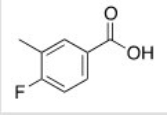
A)4-Fluoro-3-methylbenzoate
B)4-Fluoro-3-methylbenzoic acid
C)3-Methyl-4-fluorobenzoic acid
D)4-Fluoro-5-methylbenzoic acid

A)4-Fluoro-3-methylbenzoate
B)4-Fluoro-3-methylbenzoic acid
C)3-Methyl-4-fluorobenzoic acid
D)4-Fluoro-5-methylbenzoic acid

Unlock Deck
Unlock for access to all 50 flashcards in this deck.
Unlock Deck
k this deck
7
What is the product of the following reaction? 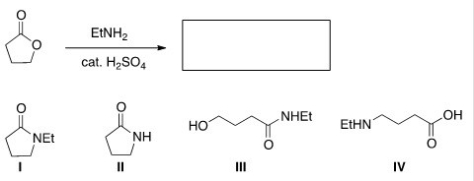
A)I
B)II
C)III
D)IV

A)I
B)II
C)III
D)IV

Unlock Deck
Unlock for access to all 50 flashcards in this deck.
Unlock Deck
k this deck
8
Which structure is consistent with the following 1H NMR spectrum? 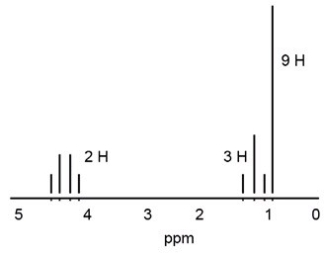
A)Ethyl acetate
B)2-Propanone
C)3,3-Dimethyl-2-pentanone
D)Ethyl 2,2-dimethylpropionate

A)Ethyl acetate
B)2-Propanone
C)3,3-Dimethyl-2-pentanone
D)Ethyl 2,2-dimethylpropionate

Unlock Deck
Unlock for access to all 50 flashcards in this deck.
Unlock Deck
k this deck
9
Which of the following is a lactam? 
A)I
B)II
C)III
D)IV

A)I
B)II
C)III
D)IV

Unlock Deck
Unlock for access to all 50 flashcards in this deck.
Unlock Deck
k this deck
10
Why is pyridine included in the reaction of an acid chloride and an amine or alcohol?
A)Pyridine will deprotonate the amine or alcohol,making it a better nucleophile.
B)Pyridine will neutralize the acid by-product of the reaction.
C)Pyridine will protonate the carbonyl of the acid chloride,making it more reactive.
D)Pyridine will absorb the heat of the reaction.
A)Pyridine will deprotonate the amine or alcohol,making it a better nucleophile.
B)Pyridine will neutralize the acid by-product of the reaction.
C)Pyridine will protonate the carbonyl of the acid chloride,making it more reactive.
D)Pyridine will absorb the heat of the reaction.

Unlock Deck
Unlock for access to all 50 flashcards in this deck.
Unlock Deck
k this deck
11
What is the structure for 3-cyanocyclopentanone? 
A)I
B)II
C)III
D)IV

A)I
B)II
C)III
D)IV

Unlock Deck
Unlock for access to all 50 flashcards in this deck.
Unlock Deck
k this deck
12
Why doesn't nucleophilic acyl substitution stop at the tetrahedral intermediate?
A)The nucleophile is too basic.
B)Reforming the carbonyl is energetically favorable.
C)The leaving group is unstable and wants to be negatively charged.
D)There is no tetrahedral intermediate.
A)The nucleophile is too basic.
B)Reforming the carbonyl is energetically favorable.
C)The leaving group is unstable and wants to be negatively charged.
D)There is no tetrahedral intermediate.

Unlock Deck
Unlock for access to all 50 flashcards in this deck.
Unlock Deck
k this deck
13
What is the structure for acetic propanoic anhydride? 
A)I
B)II
C)III
D)IV

A)I
B)II
C)III
D)IV

Unlock Deck
Unlock for access to all 50 flashcards in this deck.
Unlock Deck
k this deck
14
Where is the carbonyl absorption found in the IR spectrum of a simple ester?
A)2)5 ppm
B)2250 cm-1
C)3800 cm-1
D)1740 cm-1
A)2)5 ppm
B)2250 cm-1
C)3800 cm-1
D)1740 cm-1

Unlock Deck
Unlock for access to all 50 flashcards in this deck.
Unlock Deck
k this deck
15
What is the structure for ethyl 4-chlorobenzoate? 
A)I
B)II
C)III
D)IV

A)I
B)II
C)III
D)IV

Unlock Deck
Unlock for access to all 50 flashcards in this deck.
Unlock Deck
k this deck
16
Will the following reaction occur? 
A)Yes
B)No

A)Yes
B)No

Unlock Deck
Unlock for access to all 50 flashcards in this deck.
Unlock Deck
k this deck
17
Where do the carbonyl signals appear in the 13C NMR spectrum of carboxylic acid derivatives?
A)1700 cm-1
B)180-160 ppm
C)2)5-3.0 ppm
D)100-80 ppm
A)1700 cm-1
B)180-160 ppm
C)2)5-3.0 ppm
D)100-80 ppm

Unlock Deck
Unlock for access to all 50 flashcards in this deck.
Unlock Deck
k this deck
18
Will the following reaction occur? 
A)Yes
B)No

A)Yes
B)No

Unlock Deck
Unlock for access to all 50 flashcards in this deck.
Unlock Deck
k this deck
19
What is the IUPAC name for the following compound? 
A)2-fluorobutanonitrile
B)2-fluoropentanonitrile
C)3-fluoropentanonitrile
D)2-fluorobutylcyanide

A)2-fluorobutanonitrile
B)2-fluoropentanonitrile
C)3-fluoropentanonitrile
D)2-fluorobutylcyanide

Unlock Deck
Unlock for access to all 50 flashcards in this deck.
Unlock Deck
k this deck
20
What is the IUPAC name for the following compound? 
A)Methyl 3-methylbutanamide
B)5-Methylhexanamide
C)N-Methyl 3-methylhexanamide
D)N-Methyl 3-methylbutanamide

A)Methyl 3-methylbutanamide
B)5-Methylhexanamide
C)N-Methyl 3-methylhexanamide
D)N-Methyl 3-methylbutanamide

Unlock Deck
Unlock for access to all 50 flashcards in this deck.
Unlock Deck
k this deck
21
Which of the following two amides will react more readily with a nucleophile? Why? 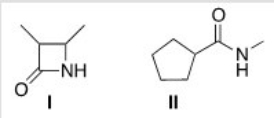
A)I,because it is less hindered
B)II,because it is less hindered
C)I,because it is more strained
D)II,because it is more strained

A)I,because it is less hindered
B)II,because it is less hindered
C)I,because it is more strained
D)II,because it is more strained

Unlock Deck
Unlock for access to all 50 flashcards in this deck.
Unlock Deck
k this deck
22
Which of the following statements about amides is true?
A)Amides react with methyl alcohol in the presence of an acid catalyst to form an ester.
B)Amides are hydrolyzed in acid or base to form carboxylic acids or carboxylate anions.
C)Amides react with thionyl chloride to form the acid chloride.
D)Amides do not react under any conditions.They are inert compounds.
A)Amides react with methyl alcohol in the presence of an acid catalyst to form an ester.
B)Amides are hydrolyzed in acid or base to form carboxylic acids or carboxylate anions.
C)Amides react with thionyl chloride to form the acid chloride.
D)Amides do not react under any conditions.They are inert compounds.

Unlock Deck
Unlock for access to all 50 flashcards in this deck.
Unlock Deck
k this deck
23
Which of the following substrates cannot be used as an immediate precursor to synthesize an ester? 
A)I
B)II
C)III
D)IV

A)I
B)II
C)III
D)IV

Unlock Deck
Unlock for access to all 50 flashcards in this deck.
Unlock Deck
k this deck
24
What is the product of the following reaction? 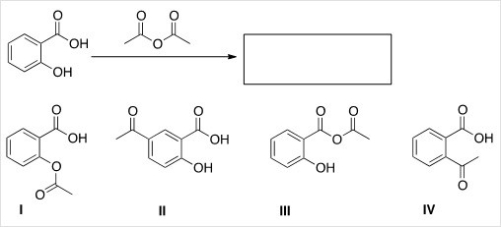
A)I
B)II
C)III
D)IV

A)I
B)II
C)III
D)IV

Unlock Deck
Unlock for access to all 50 flashcards in this deck.
Unlock Deck
k this deck
25
What is the IUPAC name for the following compound? 
A)Propionyl phenol
B)Phenyl propanoate
C)Phenol propanoate
D)Phenyl acetate

A)Propionyl phenol
B)Phenyl propanoate
C)Phenol propanoate
D)Phenyl acetate

Unlock Deck
Unlock for access to all 50 flashcards in this deck.
Unlock Deck
k this deck
26
What is the product of the following reaction? 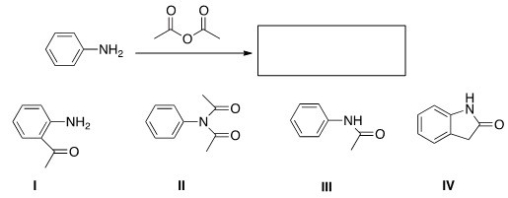
A)I
B)II
C)III
D)IV

A)I
B)II
C)III
D)IV

Unlock Deck
Unlock for access to all 50 flashcards in this deck.
Unlock Deck
k this deck
27
What is the missing reagent in the reaction below? 
A)Acetic acid
B)NaOMe
C)SOCl2
D)Pyridine

A)Acetic acid
B)NaOMe
C)SOCl2
D)Pyridine

Unlock Deck
Unlock for access to all 50 flashcards in this deck.
Unlock Deck
k this deck
28
What is the product of the following reaction? 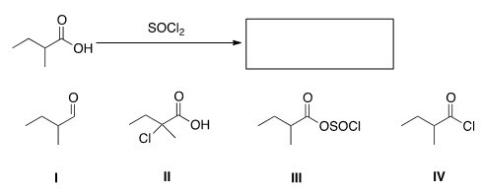
A)I
B)II
C)III
D)IV

A)I
B)II
C)III
D)IV

Unlock Deck
Unlock for access to all 50 flashcards in this deck.
Unlock Deck
k this deck
29
What is the product of the following reaction? 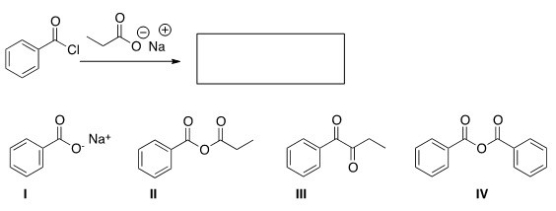
A)I
B)II
C)III
D)IV

A)I
B)II
C)III
D)IV

Unlock Deck
Unlock for access to all 50 flashcards in this deck.
Unlock Deck
k this deck
30
How can you convert a carboxylic acid into an ester?
A)Heat with an alcohol and catalytic acid.
B)Deprotonate with a base and react with an alcohol.
C)Deprotonate with a base and react with an alkyl halide.
D)Both heat with an alcohol and catalytic acid and deprotonate with a base and react with an alkyl halide.
E)Both heat with an alcohol and catalytic acid and deprotonate with a base and react with an alcohol.
A)Heat with an alcohol and catalytic acid.
B)Deprotonate with a base and react with an alcohol.
C)Deprotonate with a base and react with an alkyl halide.
D)Both heat with an alcohol and catalytic acid and deprotonate with a base and react with an alkyl halide.
E)Both heat with an alcohol and catalytic acid and deprotonate with a base and react with an alcohol.

Unlock Deck
Unlock for access to all 50 flashcards in this deck.
Unlock Deck
k this deck
31
Which of the following reaction conditions can be used to synthesize an ester (RCOOR')?
A)RCOCl + R'NH2 + pyridine
B)RCOOH + R'OH + H+
C)RCOOH + R'OH + OH-
D)RCONH2 + R'OH
A)RCOCl + R'NH2 + pyridine
B)RCOOH + R'OH + H+
C)RCOOH + R'OH + OH-
D)RCONH2 + R'OH

Unlock Deck
Unlock for access to all 50 flashcards in this deck.
Unlock Deck
k this deck
32
How can you convert a carboxylic acid into an acid chloride?
A)Heat with hydrochloric acid.
B)React with thionyl chloride (SOCl2).
C)React with sodium chloride.
D)React with Cl2 and FeCl3.
A)Heat with hydrochloric acid.
B)React with thionyl chloride (SOCl2).
C)React with sodium chloride.
D)React with Cl2 and FeCl3.

Unlock Deck
Unlock for access to all 50 flashcards in this deck.
Unlock Deck
k this deck
33
What is the product of the following reaction? 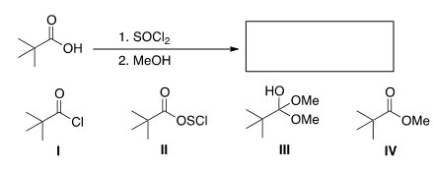
A)I
B)II
C)III
D)IV

A)I
B)II
C)III
D)IV

Unlock Deck
Unlock for access to all 50 flashcards in this deck.
Unlock Deck
k this deck
34
Draw the structure of N-phenyl acetamide. 
A)I
B)II
C)III
D)IV

A)I
B)II
C)III
D)IV

Unlock Deck
Unlock for access to all 50 flashcards in this deck.
Unlock Deck
k this deck
35
What is the product of the following reaction? 
A)I
B)II
C)III
D)IV

A)I
B)II
C)III
D)IV

Unlock Deck
Unlock for access to all 50 flashcards in this deck.
Unlock Deck
k this deck
36
What is the structure for the compound whose IUPAC name is pentyl 2-methylbutanoate? 
A)I
B)II
C)III
D)IV

A)I
B)II
C)III
D)IV

Unlock Deck
Unlock for access to all 50 flashcards in this deck.
Unlock Deck
k this deck
37
Rank the following compounds in order of increasing reactivity in nucleophilic acyl substitution. 
A)I < II < III
B)III < II < I
C)II < III < I
D)III < I < II

A)I < II < III
B)III < II < I
C)II < III < I
D)III < I < II

Unlock Deck
Unlock for access to all 50 flashcards in this deck.
Unlock Deck
k this deck
38
What is the direct product of the base-promoted hydrolysis of an ester?
A)A nitrile
B)A carboxylic acid
C)An amide
D)A carboxylic acid salt
A)A nitrile
B)A carboxylic acid
C)An amide
D)A carboxylic acid salt

Unlock Deck
Unlock for access to all 50 flashcards in this deck.
Unlock Deck
k this deck
39
From the list below,pick the compound that does not react with acetyl chloride.
A)Isopropyl alcohol
B)Benzoic acid
C)Ammonia
D)Triethyl amine
A)Isopropyl alcohol
B)Benzoic acid
C)Ammonia
D)Triethyl amine

Unlock Deck
Unlock for access to all 50 flashcards in this deck.
Unlock Deck
k this deck
40
What is the product of the following reaction? 
A)I
B)II
C)III
D)IV

A)I
B)II
C)III
D)IV

Unlock Deck
Unlock for access to all 50 flashcards in this deck.
Unlock Deck
k this deck
41
Give the IUPAC name for the following compound. 
A)Butyl ethanoate
B)Ethyl butanoate
C)4-hexanoate
D)3-hexanoate

A)Butyl ethanoate
B)Ethyl butanoate
C)4-hexanoate
D)3-hexanoate

Unlock Deck
Unlock for access to all 50 flashcards in this deck.
Unlock Deck
k this deck
42
What reagents are necessary to perform the following reaction? 
A)EtOH,H+
B)CH3CH2NH2,DCC
C)SOCl2
D)Heat

A)EtOH,H+
B)CH3CH2NH2,DCC
C)SOCl2
D)Heat

Unlock Deck
Unlock for access to all 50 flashcards in this deck.
Unlock Deck
k this deck
43
What is the product formed by hydrolysis of the following lactone with acid? 
A)I
B)II
C)III
D)IV

A)I
B)II
C)III
D)IV

Unlock Deck
Unlock for access to all 50 flashcards in this deck.
Unlock Deck
k this deck
44
An unknown compound has a sharp,medium peak at 2250 cm-1.The unknown compound is probably
A)an alkane.
B)an aldehyde.
C)an alkene.
D)a nitrile.
A)an alkane.
B)an aldehyde.
C)an alkene.
D)a nitrile.

Unlock Deck
Unlock for access to all 50 flashcards in this deck.
Unlock Deck
k this deck
45
All of the following contain sp2 hybridized atoms in their functional group except
A)a carboxylic acid.
B)a nitrile.
C)an aldehyde.
D)an anhydride.
A)a carboxylic acid.
B)a nitrile.
C)an aldehyde.
D)an anhydride.

Unlock Deck
Unlock for access to all 50 flashcards in this deck.
Unlock Deck
k this deck
46
What is the product formed by hydrolysis of the following lactone with acid? 
A)I
B)II
C)III
D)IV

A)I
B)II
C)III
D)IV

Unlock Deck
Unlock for access to all 50 flashcards in this deck.
Unlock Deck
k this deck
47
Give the IUPAC name for the following compound. 
A)R-3-methoxybutanoyl chloride
B)S-3-methoxybutanoyl chloride
C)R-2-methoxy-4-butanoyl chloride
D)S-2-methoxy-4-butanoyl chloride

A)R-3-methoxybutanoyl chloride
B)S-3-methoxybutanoyl chloride
C)R-2-methoxy-4-butanoyl chloride
D)S-2-methoxy-4-butanoyl chloride

Unlock Deck
Unlock for access to all 50 flashcards in this deck.
Unlock Deck
k this deck
48
Which of the following compounds will have the lowest frequency for carbonyl absorption in IR spectroscopy? 
A)I
B)II
C)III
D)IV

A)I
B)II
C)III
D)IV

Unlock Deck
Unlock for access to all 50 flashcards in this deck.
Unlock Deck
k this deck
49
What reagents are necessary to perform the following reaction? 
A)EtOH,H+
B)CH3CH2NH2,DCC
C)SOCl2
D)Heat

A)EtOH,H+
B)CH3CH2NH2,DCC
C)SOCl2
D)Heat

Unlock Deck
Unlock for access to all 50 flashcards in this deck.
Unlock Deck
k this deck
50
What reagents are necessary to perform the following reaction? 
A)EtOH,H+
B)CH3CH2NH2,DCC
C)SOCl2
D)Heat

A)EtOH,H+
B)CH3CH2NH2,DCC
C)SOCl2
D)Heat

Unlock Deck
Unlock for access to all 50 flashcards in this deck.
Unlock Deck
k this deck



